Seaham Sea Glass
The Most Fascinating Sea Glass in the World
Seaham Sea Glass has gone from an unknow commodity 20 years ago, to a coveted and cherished beach gem around the world. We have been lucky in being the first USA artist to work with these unaltered gems.
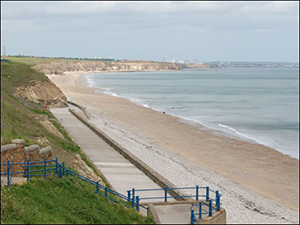 Seaham is a small coastal town in the North East of England not far from Sunderland and Newcastle in Durham County, famed for its glass making history.
Seaham is a small coastal town in the North East of England not far from Sunderland and Newcastle in Durham County, famed for its glass making history.
Though glass making in England could date back to the Romans, glass dating from the mid 1800's is a more likely source for this amazing English sea glass.
Seaham is also the home of the now famed and much sought after Multi Colored Sea Glass (or Multi or Multie) and as far as we know, one of only three sources in the WORLD for mixed multi-color NATURAL Art Sea Glass.
Before we starting selling English sea glass, this glass was only known to a few souls in the USA. Due to the popularity of our site for jewelry and sea glass info, we are proud to have had a hand in creating a cottage industry in this small seaside hamlet.
Glass Making in The Region
There were many glass companies throughout in this region but, due to tides, wind and geography, this small stretch of beach yields sea glass from Victorian Era Glass factories. These art glass factories around the Tyne and Wear Region practiced many forms of decorative glassware and this tiny nook of a beach in Seaham, right in the downtown off the promenade of this quiet village provides some of the finest sea glass in the world.
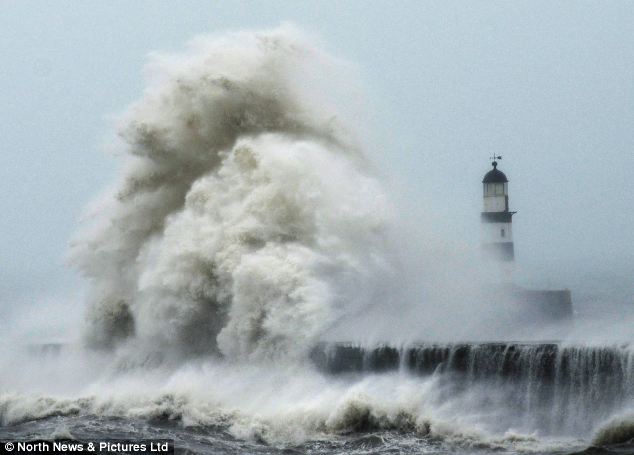 The North Sea is as treacherous, turbulent and rocky. During storms, great boulders sometimes get washed up on the town promenade. The constant wave action and rocky beaches are the perfect formula for top grade sea glass.
The North Sea is as treacherous, turbulent and rocky. During storms, great boulders sometimes get washed up on the town promenade. The constant wave action and rocky beaches are the perfect formula for top grade sea glass.
End Of Day Glass (or .....EndO'Day coined by us in 2004) is heavily frosted sea gems of distinctive quality.
The glass production in the area was strongest during the late 1800's to the early industrial era. Sunderland, the closest city, houses the National Glass Centre. They display the various wares made in the region during this period.
The large coal pockets below the city and a large accessible harbor made this a perfect region for glass production. Many glass houses existed during the period. In town, the famous Londonderry Bottleworks was the largest bottle manufacturer in England. They turned out over 20,000 handblown bottles a day that shipped around the world. This source is attributed for the vast amount of white, green, brown, aqua and seafoam sea glass.
There are several types of glass from this area. Large rounded single colors or Bubbles and Boulders, Fisheyes, Marbles, Flash Glass and the much sought after Multi's and the elusive Frigger or Whimsey.
The introduction of machine made bottles made Seaham’s hand crafted bottles obsolete. The company transferred its work to London and closed down the Seaham factory during the 1921 coal strike.
Types Of English Sea Glass (Seaham Sea Glass)
There are several different distinct types of sea glass that come from this beach.

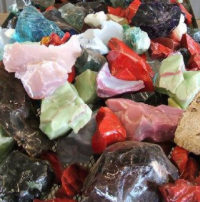 Boulders and Bubbles - Most always, these are single color pieces that started as huge pieces of slag or cullet glass. These "lumps" of glass once discarded into the sea, have rolled around for over 100 years.
Boulders and Bubbles - Most always, these are single color pieces that started as huge pieces of slag or cullet glass. These "lumps" of glass once discarded into the sea, have rolled around for over 100 years.
This is why boulder or bubble characteristics are that they are very round and sometimes very large.
Slag glass (pictured here) can still be purchased today from modern glass companies and is often used in aquariums for display or in landscaping.
We use bubbles in our minimal bezel setting and our NEW Deluxe Wire Bezel setting where a silver Bezel is fashioned to the exact size of the glass. Most bubbles are too round for most jewelry applications and tend to fracture when drilled.
Multi Seaham Sea Glass
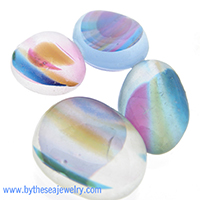 Multi's - There are various theories on how Multi's came to be. We incorrectly reported this glass (see above) to be purposefully mixed at the "End Of The Day' either worked by glass workers as practice or simply combined in one vat as waste is now widely spread on the internet to describe Seaham Sea glass. This was believed because of the total randomness of the colors in multis.
Multi's - There are various theories on how Multi's came to be. We incorrectly reported this glass (see above) to be purposefully mixed at the "End Of The Day' either worked by glass workers as practice or simply combined in one vat as waste is now widely spread on the internet to describe Seaham Sea glass. This was believed because of the total randomness of the colors in multis.
We now believe that this is an INCORRECT definition of how this glass came to be.
UPDATED INFO on the Seaham Multie Source...
In the last year, we found this possible source for this sea glass. A glass house by the name of Hartley & Wood Company produced many forms of glass in this region. The art glass that was brought to our attention while browsing social media. This art glass called Streaky Glass Pieces, was produced in Sunderland at the plant at Trimdon Street and Deptford Road, just minutes from the Sunderland harbor on the River Wear.
I believe it would have been IMPOSSIBLE for these colors to have originated from the Bottleworks. No where in history are there hot pink, electric aqua or blue bottles. Most bottles were white or shades of green. This accounts for the large quantities of these colors of sea glass on the beaches of Seaham.
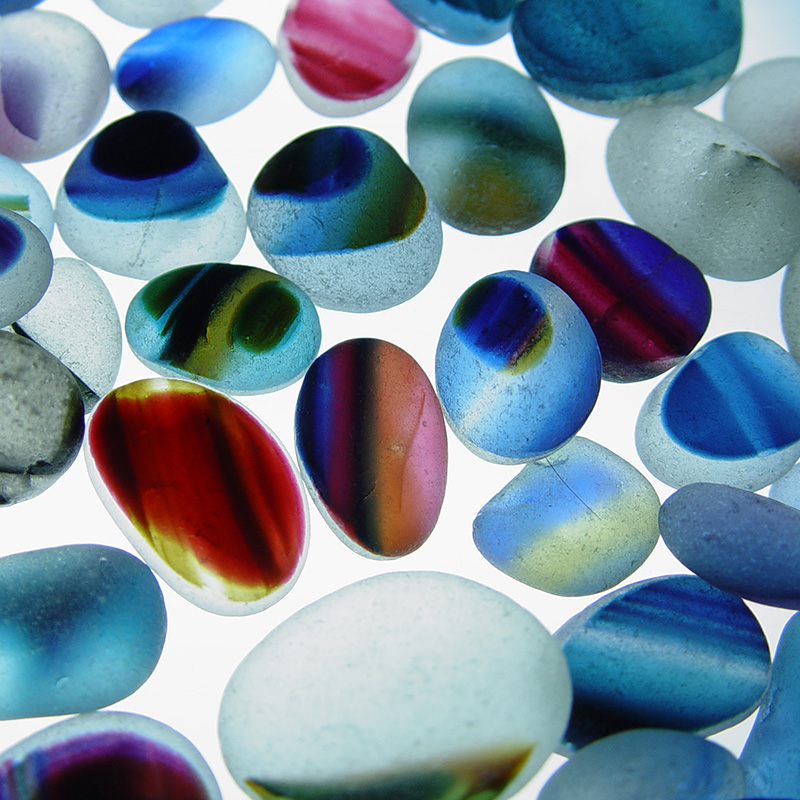
Below are some of the rare examples of The Hartley Wood & Company works showing you some rare "multies" and some examples of their work from the late 1800's. When you compare the colors in the Multi Sea Glass pieces to various Hartley and Wood Company work, it does not take an art glass expert to see these are the same EXACT colors and color mixtures.
Since this has also been confirmed and verified by and English Art Glass professor and historian, we are assured of our accounting of this source.
While there are MANY types of sea glass found on this small English beach, pontils, flashed glass, boulders and bubbles, etc... the most amazing and the most desirable sea glass from the area is the coveted "Ultra Rare Multi".
To View our Seaham Sea Glass Jewelry - CLICK HERE!
Multi Or End Of Day Sea Glass
End Of Day Glass" - (how the term came about).
While conversing with our Brit "friend" about the origins of this glass....(She simply called it sea glass) I wanted to know more about why this beach yielded some of the most unique sea glass in the world.
With my study of glassmaking and glass history, I thought that these amazing mixed color sea glass pieces were glass mixed together and discarded at the end of the day.
True End Of Day Glass
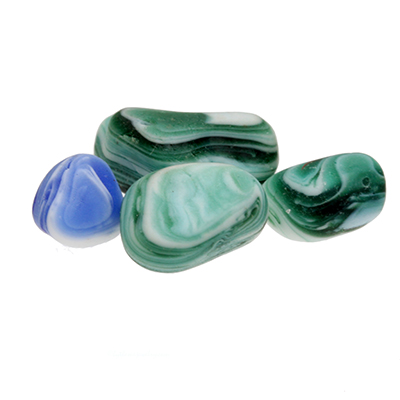 "End Of Day" glass in glass making is where glass frits (small bits of ground colored glass) are incorporated into and final end piece producing a multi colored effect. Some End of Day glass used white or milk glass with left over glass colors. English End Of Day sea glass is seldom like true "End Of Day Glass" in collecting.
"End Of Day" glass in glass making is where glass frits (small bits of ground colored glass) are incorporated into and final end piece producing a multi colored effect. Some End of Day glass used white or milk glass with left over glass colors. English End Of Day sea glass is seldom like true "End Of Day Glass" in collecting.
True End Of Day sea glass IS found on this beach (right picture), but it is much more rare than even the lovely multis.
Traditional End Of Day glass is still produced by modern glass makers like the vases pictured here.
Glass Making In The Region...
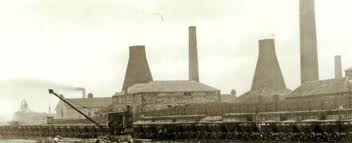
Though there were dozens of glass makers in Northern England, most glass product were utilitarian. Hand Blown Bottles, sheet glass for windows and roofs and such we made by numerous glass makers within miles of the Seaham Beaches. This source however, would have ONLY produced the more common colors of glass (Green, Brown, White Aqua and Seafoam). The more colorful Multis including colors of Hot Pink, Orange, Red, Teals etc, COULD NOT HAVE originated from bottle glass.
For more info on Hartley Wood Glass See
Historic Glass In England (a great read)
Examples of Hartley Wood Streaky Art Glass Pieces and Seaham Sea Glass Pieces
|
Hartley & James Streaky Glass |
Seaham Sea Glass Pieces |
Seaham Sea Glass Jewelry |
 |
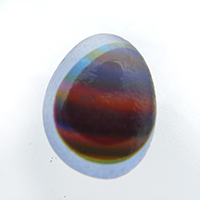 |
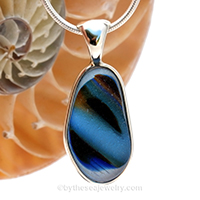 |
 |
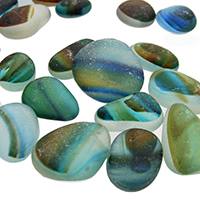 |
 |
 |
 |
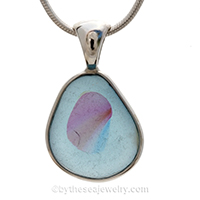 |
 |
 |
 |
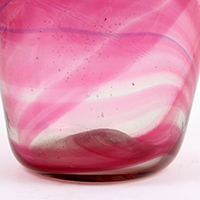 |
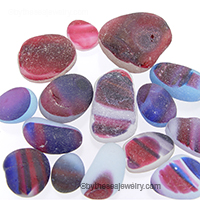 |
 |
 |
 |
 |
Nowhere in the world can this type of sea glass be found other than this small region.
The best Multi's are those with 3 or more colors, and our favorites are cross sectioned pieces (shown left above) where the colors are cross sectioned inside the glass instead of layered one on top of another.
The rarest Seaham Multis we have seen have a rainbow of hues and layers (called Peacock Glass).
Other Types of Seaham Sea Glass
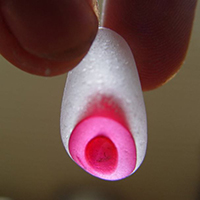
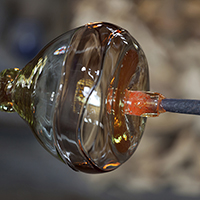
Pontil Pieces (as I refer to them) Or Fisheyes (as they are called in Seaham) are usually clear glass with a tip of color used to tip a punty or pontil rod (This is the metal rod used to gather glass in the kiln).
Pictured right is an example of hot glass on a punty rod. The glowing part is the pontil piece.
Clear glass was the cheapest and therefore dominates the fisheyes found in this area, however, occasionally brightly colored fisheyes bases are found.
We have several in our personal collection where the bases are hues of aqua and blue, light blues and greens.
In a fisheye piece, you can see how the glass was pulled before being snapped off for final finishing. The center of the glass remained hot and therefore stretched more as the outside cooled and was more stable. Most fisheye or pontil pieces from Seaham have this characteristic though many are just a hint of color on a tip of white.
It is many years of glass knowledge that led me to this conclusion and though this is just MY THEROY. Fisheyes may have originated in a different way. It seems though to be the most accepted theory throughout the sea glass community and among glass experts.
I firmly though believe that due the thickness of most Fisheyes or Pontil pieces, that they were indeed punty tips. Unfortunately, the affirmation of this knowledge has passed with the generation of glass makers that produced these discards.
Most sea glass experts, jewelry artists and collections seem to agree in whole or portions of our theory and many have used it on websites and in articles to describe this unique sea glass.
Flashed Glass
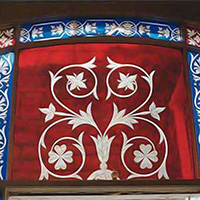 Flashed Glass - So popular in Victorian English windows Flash Glass (pictured left) is where one color of glass is layered on top of another, then carved to reveal a contrasting pattern.
Flashed Glass - So popular in Victorian English windows Flash Glass (pictured left) is where one color of glass is layered on top of another, then carved to reveal a contrasting pattern.
Flash glass was also used in decorative house wares (left - Victorian Glass Set) such as vases and bowls and other decorative glass wares.
Flash sea glass in distinctly 2 colors (rarely 3) and an even usually flat surface. We also collect Flash Sea Glass from Southern England.
Flashed Seaham sea glass tends to be flatter. This indicates that it was most likely window glass color where glass was rolled on top of each other.
Whimsies - Friggers and Other Pieces

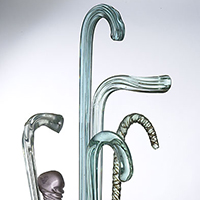 Whimsies or Friggers and other fascinating specimens can be found in Seaham. In glass making these were usually items made by workers at the end of the day to practice their trade.
Whimsies or Friggers and other fascinating specimens can be found in Seaham. In glass making these were usually items made by workers at the end of the day to practice their trade.
Items such as glass canes and pipes (impractical but pretty), pitchy dobbers (flat pressed glass used in game like hop scotch) and glass dumps, paper weights with designs blown inside (see our personal find of a sea glass flower dump - pictured left with a Victorian Dump).
These are sometimes also called End Of Day pieces as they were made with glass that would have been "dumped" out at the end of the production day. Pieces of failed attempts of these items can sometimes be found on the beaches in this area.
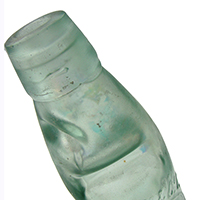 Sea Glass Marbles - also abound on this beach and originate mainly from Codd bottles. These bottles had an internal marble that was pushed to the top of the bottle by the carbonation, thus sealing the opening.
Sea Glass Marbles - also abound on this beach and originate mainly from Codd bottles. These bottles had an internal marble that was pushed to the top of the bottle by the carbonation, thus sealing the opening.
These were also made locally, Villa Pop, a Sunderland company who started making soda in the late 1800's, made Codd bottles from 1900 to 1912, which gives those marbles a direct date.
The wares that were made in these and around Seaham varied throughout time and the sea glass found there tells their tales.
As a decorative or art glass factory which yielded incredible colors of glass in pinks, baby blues in the Deco Period to specimens of Victorian decorative artifacts can be seen at The National Glass Centre in Sunderland.
In later years, less glamorous objects such as bottles, television tubes (producing a thick gray blue sea glass), and more common colors such as olives and ambers that have distinct color unlike any found anywhere else in the world.
Though the bottle factory also produced the common colors of sea glass, the quality is far better than any we have ever seen because of the conditions of the North Sea.
To view our English Sea Glass from Seaham England, you can check this LINK!
By The Sea Jewelry's Connection to Seaham
We were introduced to Seaham Sea Glass just about 17 years ago by a resident collector in England.
Having never before having seen it, I was a bit skeptical as to the colors. It did not look like any other sea glass in the world. I purchased all the solid colors I could and was convinced by the collector that the multie colored pieces were really what locals in County Durham sought on their beach trips.
The glass at that time was plentiful and we purchased and traded as much as we possibly could. We spent a lot of time and money developing a relationship with the collector there.
When we put it on our site in the form of jewelry, the amount of collectors sky rocketed and batches of Seaham Sea Glass soon started to appear on Ebay and then later Etsy.
Our Friend/Collector soon was wooed by other sea glass artists in the USA and our secret source for this amazing sea glass was no longer ours alone. It was also at this time that we started Seaglasslovers, a site for collectors all over the world. Since we could no longer source large amounts of glass, we decided to disclose the town where the sea glass was found. Sadly, our friendship with the collector also went by the wayside due to inaccuracies that the Brit was telling us.
Seaham has now developed into a Beach Bucket list item or Mecca for sea glass collectors the world over. It has a cottage industry of B&B's tours, sea glass collectors and jewelry stores.
Once available in large batches and by the pound, Seaham Sea Glass is now sold by the single piece making it almost impossible for the emerging sea glass artist to acquire enough glass to say, match for earrings.
We are proud to be able to offer Jumbo Multies (the average size in the USA in under 1/2 inch). Our Multie pendants range from 3/4 of an inch up to 2 inches.
